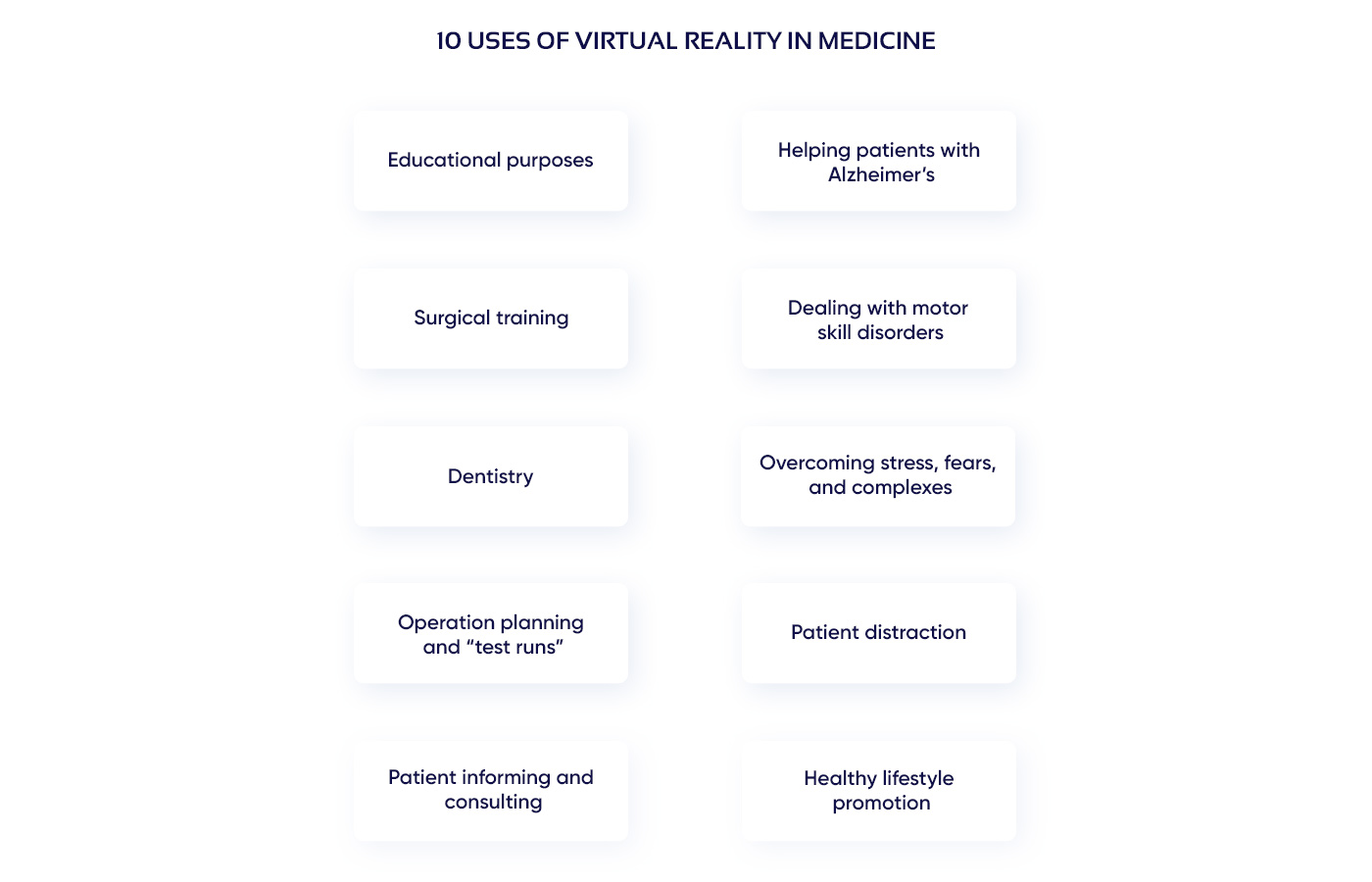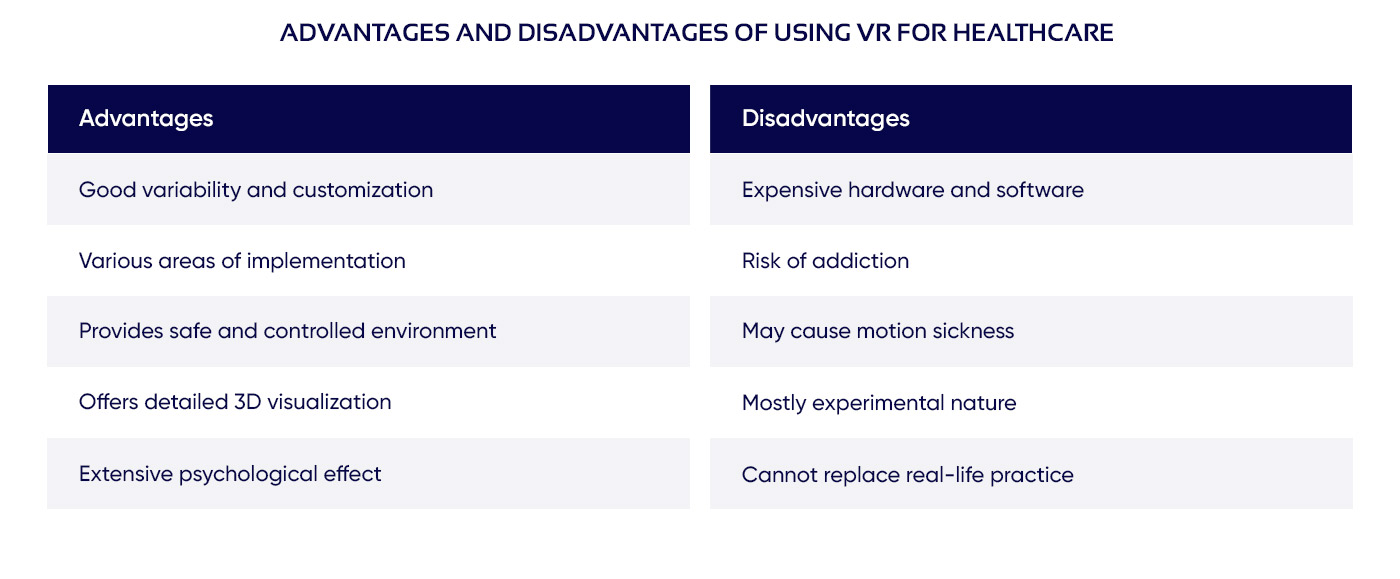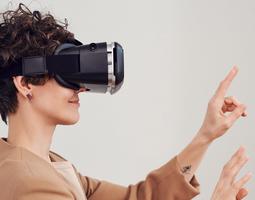For many years, the fascinating concept of virtual reality was mentioned exclusively in the science fiction literature and movies as there were no means to ensure fully immersive experience. Providing the satisfactory quality of the 3D environment in terms of graphics, sound, and physics requires advanced computational, audio, and video technologies that became available relatively recently. Even then, the use of VR was mostly limited to the entertainment industry or military implementations. It was not until the 21 century when the virtual reality technology evolved enough to offer believable virtual worlds with the help of compact, convenient, and more affordable devices. As a consequence, the concepts of virtual and augmented reality found new practical implementations in various industries, and one of them is the use of AR and VR in the medical field.
10 Uses of Virtual Reality in Medicine
Modern technological advances have successfully connected virtual reality and medicine in order to bring numerous beneficial features for both doctors and patients. Currently, there are multiple research facilities dedicated to studying and implementing virtual and augmented realities in the healthcare field, for example, the University of Southern California Institute for Creative Technologies. The list presented below contains merely a few exemplary areas of use, and the scientists will certainly devise many new ways to implement VR/AR in the healthcare industry as the technology develops further.

1. Educational purposes
One of the most widespread uses of VR and AR is for the purposes of education, both theoretical and practical. Similar to tourists that take virtual walks through modeled landmarks, medical students take virtual tours along the systems of the human body to see how it works from the inside. For instance, instead of keeping organs in jars as exhibitions for studying, medical schools can offer their high-definition 3D models that are far more convenient and illustrative.
As for practical skills, VR enables creation of customized environments and scenarios, for example, for paramedic training under realistic and optionally stressful conditions. This technology may also help in learning how to handle various medical devices and tools as it allows to employ them in a safe virtual world. Last but not least, virtual/augmented reality devices reduce or completely obviate the conventional use of dead bodies as visual aids and training dummies in medical training.
2. Surgical training
Virtual reality allows practicing practical skills with great cost saving but without facing real-life consequences. This makes VR invaluable for practicing skills that are required for high-risk activities, such as surgery. A mistake during the surgery on a virtual patient will not harm or take somebody’s life but will provide useful learning experience for a student due to realistic visuals and feedback. This way, specialized VR training platforms like OssoVR, for example, allow the more frequent and regular practice of various surgical procedures with adjustable settings and preset scenarios to hone skills and learn from mistakes.
3. Dentistry
Similar to surgeons, dentists also benefit from the same advantages offered by medical virtual reality devices. They are able to practice their skills on virtual patients or even 3D models of teeth using special drills configured to imitate real-life tactile feedback. An example of such a virtual dental training system is called hapTEL and was presented in 2010 as a breakthrough learning method instead of the conventional way involving mannequins with plastic teeth.
4. Operation planning and “test runs”
Three-dimensional models offered by AR and VR technologies proved to be invaluable during preparation stages before complex surgeries. Using 3D imagery based on MRI and/or CT scans, surgeons obtain precise models of patients’ organs or bodies, for example, three-dimensional visualization of tumors and surrounding tissues. Doctors can examine these models from different angles, cross-sections, or cutaway views, and plan possible scenarios of future operations. They can even practice operations in virtual operating rooms in order to calculate and test the optimal sequence of process steps before using real scalpels on live patients.
5. Patient informing and consulting
3D visualization of CT results is useful not only for surgeons but also for family therapists and other doctors in order to explain patients the effects of their illnesses by showing what is wrong with their bodies using three-dimensional models in virtual environment. Besides, this feature may be beneficial for doctors consulting over the Internet when it is difficult or physically impossible for a patient to meet the doctor.
6. Helping patients with Alzheimer’s
Scientists have already proven the positive effects of VR for diagnosing Alzheimer’s disease and relieving its symptoms. For example, the researchers at Cambridge University designed and implemented a navigation test that uses virtual reality to detect patients with early Alzheimer’s and is more reliable than a conventional cognitive assessment. One innovative project named “ The Wayback” aims at triggering precious memories and stimulating conversations in patients in order to battle the effects of dementia and improve communication between patients and their families or carers.
7. Dealing with motor skill disorders
Many types of illnesses and traumas can lead to the severe damage of the brain, limbs, the nerve system that, in its turn, causes motor skills to deteriorate or even disappear. Regaining these skills requires an extensive rehabilitation period and can benefit from using virtual reality. For example, MindMaze uses VR to help stroke patients to regain control over their bodies. Virtual reality also proved its effectiveness in helping patients with Parkinson’s disease to improve their balance skills.
8. Overcoming stress, fears, and complexes
Virtual reality can be effectively applied in psychotherapy as a method of treating various phobias and other mental health conditions. The technology allows doctors to create controllable environment and put patients in uncomfortable conditions preset individually for each particular case in order to train them to overcome their fears and gain confidence. Several examples of phobias that can be treated in such a way are fear of open or confined spaces, fear of various living beings, stage fright, fear of heights or water, and so on.
Another condition that can be effectively treated using virtual reality devices is the post-traumatic stress disorder generally diagnosed in catastrophe survivors, soldiers, and generally any individuals who have to operate in extremely stressful operations on a daily basis. The immersive experience provided by VR can also be used as a relaxation therapy to deal with various anxieties and stress-related disorders. One illustrative example of such applications is Anxiety RelieVR developed for Samsung Gear VR devices by Applied VR.
9. Patient distraction
Medical VR found another implementation as an effective distractor that has several similar uses related to relieving pain and discomfort of patients. The researchers proved the effectiveness of VR in treating chronic pain by switching the patients’ focus on the virtual environment. One example of such implementation is the Pain RelieVR software built by the aforementioned company Applied VR.
The soothing effect of virtual reality provided by specifically designed audio and visuals is strong enough to be applied during childbirth. This way, VR can substitute epidural anesthesia and other drugs or administration methods designed to reduce labor pain.
10. Healthy lifestyle promotion
The excellent visual impact of virtual reality can be used to educate people, especially the youth, about the harmful effects of such habits as smoking, alcohol and drug abuse, an unwholesome diet, sedentary lifestyle, and others. Illustrative 3D models can show how the human body gradually changes under the influence of such habits and how long does it take to recover, fully or partially, from the damage. Such visualization presents an intelligible and relatable method of promoting a healthy life and urging people change their lives before it’s too late.
Pros and Cons of Using VR in Medicine
As with most technological advances, the intended implementations of virtual/alternate reality devices in healthcare may have both advantages and drawbacks depending on various factors. This section of the article will summarize the positive effects of VR in medicine, as well as define the possible negative outcomes.

Advantages of virtual reality in medicine
Researchers have have identified several beneficial effects associated with the great visual impressions provided by the VR/AR technology. Some exemplary practical implementations in the field of medicine are listed below.
1. Enhanced flexibility and customization options
VR technologies allow to create any required environment according to specific purposes. These environments may be either life-like or unrealistic, as needed, and all of them are accessed from the same room via a VR headset. Thus the room with the VR equipment can be easily turned into a virtual operation room, a relaxing beach, an obstacle course, a small boat in the middle of the ocean, and all these environments would serve medical purposes.
2. Can be applied in various healthcare areas
Due to its highly customizable nature, VR may be effectively used for a number of healthcare-related activities. The examples are given in the previous section of this article, but keep in mind that the list is not exhaustive, and scientists are constantly researching and testing new implementations.
3. Offers user experience in controlled environment
Another invaluable benefit of VR technologies used for treatment is that patients remain in safe conditions under the supervision of doctors. Thus, the therapy may be stopped whenever a patient feels any discomfort or their vitals start to change for the worse.
4. Provides detailed 3D images
Virtual reality is often used to provide three-dimensional models for precise and illustrative visualization that is far more advanced in comparison with conventional 2D scans. This feature is advantageous for both patients and doctors, especially surgeons.
5. Unparalleled psychological impact
It is hard to compete with VR in terms of its influence on patients’ minds. No other tech can make patients perceive artificial worlds as reality through sight and hearing. Various types of immersive experience are especially helpful for people with disabilities, suffering from psychological or neurological disorders, chronic pain, and other conditions.
Disadvantages of virtual reality in medicine
As a rule, most benefits come at some cost, and VR is no exception from this rule. Let’s review the drawbacks associated with using virtual/augmented reality devices in medicine.
1. High cost of equipment and software
Most implementations of VR in medicine involve complex hardware and elaborate computer programs to evoke the believable experience. While there are some charity-funded projects that use cardboard boxes and smartphones instead of VR glasses and headsets, they usually lack the required immersion and realistic atmosphere. However, it is possible to reduce software development costs by using ready-made VR software development kits and game engines, such as Unity or Unreal engines and relevant Oculus SDKs, though it might be challenging to adapt them to healthcare purposes.
2. Possibly addictive
Gaming addiction has already become a recognized problem, and the possibility of VR addiction also raises the concern of doctors. The risk is especially high for patients with dementia who have difficulties in recognizing and interacting with the real world. Patients with severe disabilities may also be prone to VR addiction, as they might prefer escaping to the virtual world.
3. May disorient users
One of the well-known drawbacks of virtual reality devices is the tendency to cause nausea, vertigo, disorientation, or other similar symptoms in some users even during gaming. Patients may generally be more susceptible to such effects due to their health conditions.
4. Lack of extensive trials and use history
Designing, implementing, and approving new treatment methods require significant time and must follow a strict procedure. Since the technologies related to virtual and augmented reality are still under extensive development, they often lack proper trial runs, and their use is considered experimental.
5. Does not provide sufficient training
While the illustrative aspect of VR is amazing for educational purposes, their use for skill training cannot compete with real-life practice. Even elaborate training complexes for dentists or surgeons cannot provide completely realistic feedback, especially in terms of tactile response.
Conclusion
Looking at the listed examples of using virtual reality in medicine and surgery in particular, it is obvious that this technology will cover more areas in the future. Even in their current state, VR and AR offer numerous benefits that help doctors to save lives. They also provide quality-of-life improvements for patients, including those with severe motor disorders, dementia, or other psychological conditions. So, if you want a VR software product designed for the healthcare industry, contact us, and we’ll provide you a high-quality solution!




